Microstructure, Hardness, and Tensile Properties of Vacuum Carburizing Gear Steel
Abstract
:1. Introduction
2. Experimental
3. Result and Discussion
3.1. Microstructure
3.2. In-Depth Hardness Distribution
3.3. Tensile Properties
3.4. Fractography
3.5. Transformation of Retained Austenite
4. Conclusions
- (1)
- The content of retained austenite in the carburized case of the specimens of the experimental steel was measured to be 18–30%, which was dependent on the austenitizing temperature. This is related to the carburized carbon content and the carbide dissolution at the austenitizing temperature.
- (2)
- The tensile stress–strain curves of carburized specimens of the experimental steel showed a similar work hardening exponent of 0.4 and did not vary with the austenitizing temperature. The stress–strain curves were described by considering the carburized case and the core in combination.
- (3)
- Although the case hardness of 800 HV0.2 and the carburized depth of 1.2 mm were similar, the fracture stresses of the carburized specimens showed a decreasing trend with the increasing austenitizing temperatures. Observations of fracture surfaces indicated that cracks initiated at the near-surface carburized case and propagated first in an intergranular mode. The high fracture stress of the 840 °C austenitized specimen was related to the fine microstructure and high percentage of retained austenite transformed into martensite during the tensile tests.
- (4)
- The optimum austenitizing temperature for the experimental steel was determined to be around 840 °C when the fracture stress could be expected to be as high as 1900 MPa.
Author Contributions
Funding
Acknowledgments
Conflicts of Interest
Nomenclature
| MVC | Microvoid coalescence |
| SEM | Scanning electron microscope |
| XRD | X-Ray diffraction |
| Cp | Carbon potential during carburizing |
| Vγ | Volume fraction of retained austenite |
| Ms | Start temperature of martensitic transformation |
| Tq | Quenching temperature |
| α | A constant of martensitic phase transformation with the value of 1.10 × 10−2 |
| α’ | Martensite |
| AC3 | Transformation temperature of ferrite into austenite for hypoeutectoid steel |
| σC | Fracture stress |
| E | Elasticity modulus |
| γ | Surface energy |
| a | Crack length |
| f0 | Content of retained austenite at the initial time |
| fγ | Content of retained austenite at a certain time |
| ε | Deformation strain |
| k | A constant indicating mechanical stability of retained austenite |
| C | Carbon |
| Mn | Manganese |
| Si | Silicon |
| P | Phosphorous |
| S | Sulfur |
| Fe | Iron |
| Cr | Chromium |
| Ni | Nickel |
| Mo | Molybdenum |
| V | Vanadium |
| W | Tungsten |
References
- Parrish, G. Carburizing: Microstructures and Properties; ASM International: Geauga, OH, USA, 1999. [Google Scholar]
- Seo, E.J.; Speer, J.G.; Matlock, D.K.; Cryderman, R.L. Effect of Mo in combination of Nb on austenite grain size control in vacuum carburizing steels. J. Mater. Eng. Perform. 2020, 29, 3575–3584. [Google Scholar] [CrossRef]
- Henry, E.C.; O’Brien, C.; Yeddu, H.K. Multi-length scale modeling of carburization, martensitic microstructure evolution and fatigue properties of steel gears. J. Mater. Sci. Technol. 2020, 49, 157–165. [Google Scholar]
- Ma, L.; Wang, M.Q.; Shi, J.; Hui, W.J.; Dong, H. Influence of niobium microalloying on fatigue properties of case hardening steels. Mater. Sci. Eng. A 2008, A498, 258–265. [Google Scholar] [CrossRef]
- Liu, Y.; Wang, M.Q.; Shi, J.; Hui, W.J.; Fan, G.; Dong, H. Fatigue properties of two case hardening steels after carburization. Int. J. Fatigue 2009, 31, 292–299. [Google Scholar] [CrossRef]
- Luther, R.G.; Williams, T.R.G. The tensile properties of carburized and uncarburized low carbon mild steel. J. Mater. Sci. 1974, 9, 136–144. [Google Scholar] [CrossRef]
- Krauss, G. The microstructure and fracture of a carburized steel. Metall. Mater. Trans. A 1978, 9, 1527–1535. [Google Scholar] [CrossRef]
- Furukawa, T.; Konuma, S.; Sakaniwa, H. Effects of chemical composition and heat treatment on mechanical properties of carburized steels. Tetsu Hagane 1979, 65, 1204–1212. [Google Scholar] [CrossRef]
- Li, F.Z.; Li, C.Z. The influence of heat treatment after carburizing and retained austenite in the carburized layer on the strength and toughness of steel. Trans. Heat Treat. Met. 1985, 6, 59–68. [Google Scholar]
- Erdogan, M.; Tekeli, S. The effect of martensite volume fraction and particle size on the tensile properties of a surface-carburized AISI 8620 steel with a dual-phase core microstructure. Mater. Charact. 2003, 49, 445–454. [Google Scholar] [CrossRef]
- Murai, N. Intergranular fracture of carburized steel. In Mechanical Behavior of Materials VI; Pergamon: Kyoto, Japan, 1992. [Google Scholar] [CrossRef]
- Yu, E.J.; Jung, H.J.; Kim, K.S.; Kim, E.J.; Kim, J.Y. Influence of carbide formation on tensile and fatigue properties of carburized steels. Appl. Microsc. 2013, 43, 81–87. [Google Scholar] [CrossRef] [Green Version]
- Farivar, H.; Deepu, M.J.; Hans, M.; Phanikumar, G.; Bleck, W.; Prahl, U. Influence of post-carburizing heat treatment on the core microstructural evolution and the resulting mechanical properties in case-hardened steel components. Mater. Sci. Eng. A 2019, 744, 778–789. [Google Scholar] [CrossRef]
- Neu, R.W.; Sehitoglu, H. Stress-induced transformation in a carburized steel-Experiments and analysis. Acta Metall. Mater. 1992, 40, 2257–2268. [Google Scholar] [CrossRef]
- Silva, V.F.; Canale, L.F.; Spinelli, D.; Bose-Filho, W.W.; Crnkovic, O.R. Influence of retained austenite on short fatigue crack growth and wear resistance of case carburized steel. J. Mater. Eng. Perform. 1999, 8, 543–548. [Google Scholar] [CrossRef]
- Roy, S.; Sundararajan, S. The effect of heat treatment routes on the retained austenite and tribomechanical properties of carburized AISI 8620 steel. Surf. Coat. Technol. 2016, 308, 236–243. [Google Scholar] [CrossRef]
- Benselya, A.; Senthilkumara, D.; Mohan, L.D.; Nagarajana, G.; Rajaduraib, A. Effect of cryogenic treatment on tensile behavior of case carburized steel-815M17. Mater. Charact. 2007, 58, 485–491. [Google Scholar] [CrossRef]
- Baldissera, P.; Delprete, C. Effects of deep cryogenic treatment on static mechanical properties of 18NiCrMo5 carburized steel. Mater. Des. 2009, 30, 1435–1440. [Google Scholar] [CrossRef]
- Magee, C.L. Phase Transformation; ASM: Geauga, OH, USA, 1970; p. 115. [Google Scholar]
- Brooks, C.R. Principles of the Heat Treatment of Plain and Low Alloy Steels; ASM International: Geauga, OH, USA, 1996; p. 307. [Google Scholar]
- Pavlina, E.J.; Van Tyne, C.J. Correlation of yield strength and tensile strength with hardness for steels. J. Mater. Eng. Perform. 2008, 17, 888–893. [Google Scholar] [CrossRef]
- Cular, I.; Vuckovic, K.; Zezelj, D.; Glodez, S. Analytical approach for low and high cycle bending fatigue life prediction of carburized gear steel specimens. Eng. Fail. Anal. 2020, 108, 104328. [Google Scholar] [CrossRef]
- Griffth, A.A. Phenomenon of rupture and flow in solids. Philos. Trans. R. Soc. Lond. 1921, A221, 163–198. [Google Scholar]
- Sugimoto, K.; Yu, B.; Mukai, Y.; Ikeda, S. Microstructure and formability of aluminum bearing TRIP-aided steels with annealed martensite matrix. ISIJ Int. 2005, 45, 1194–1200. [Google Scholar] [CrossRef] [Green Version]
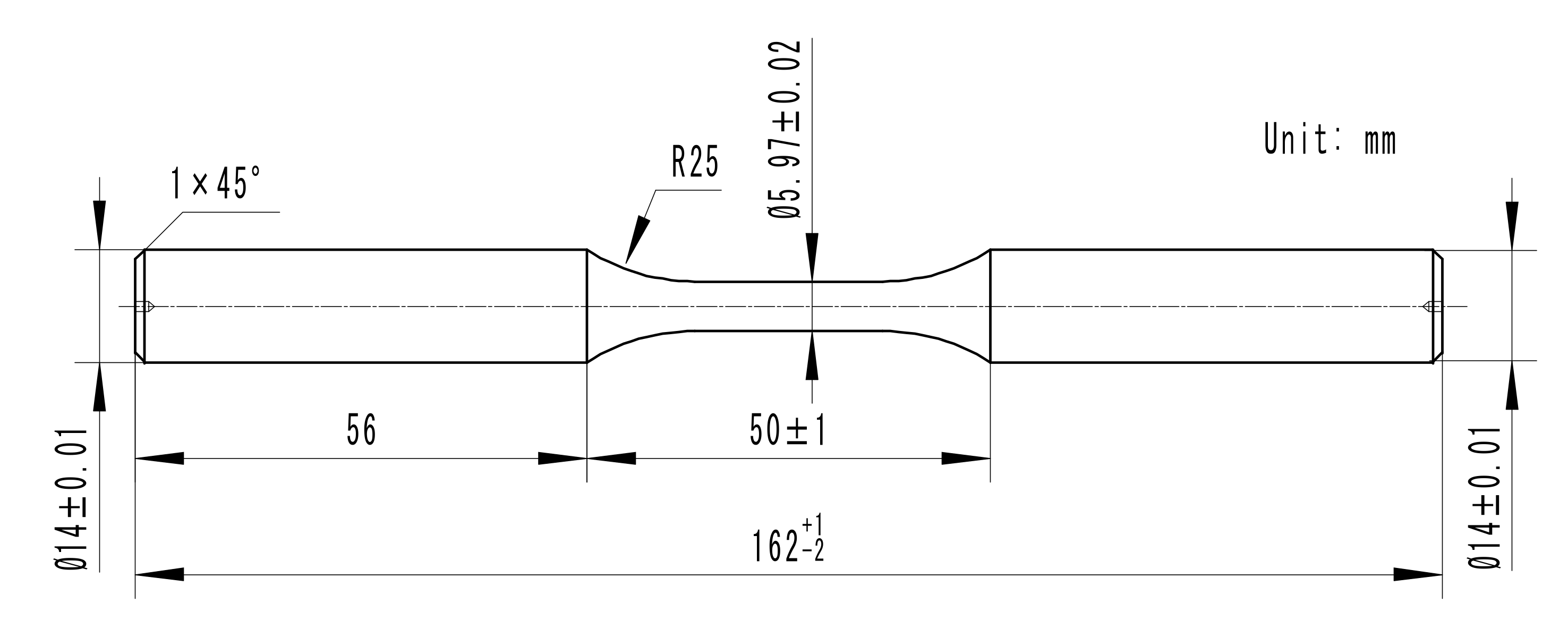
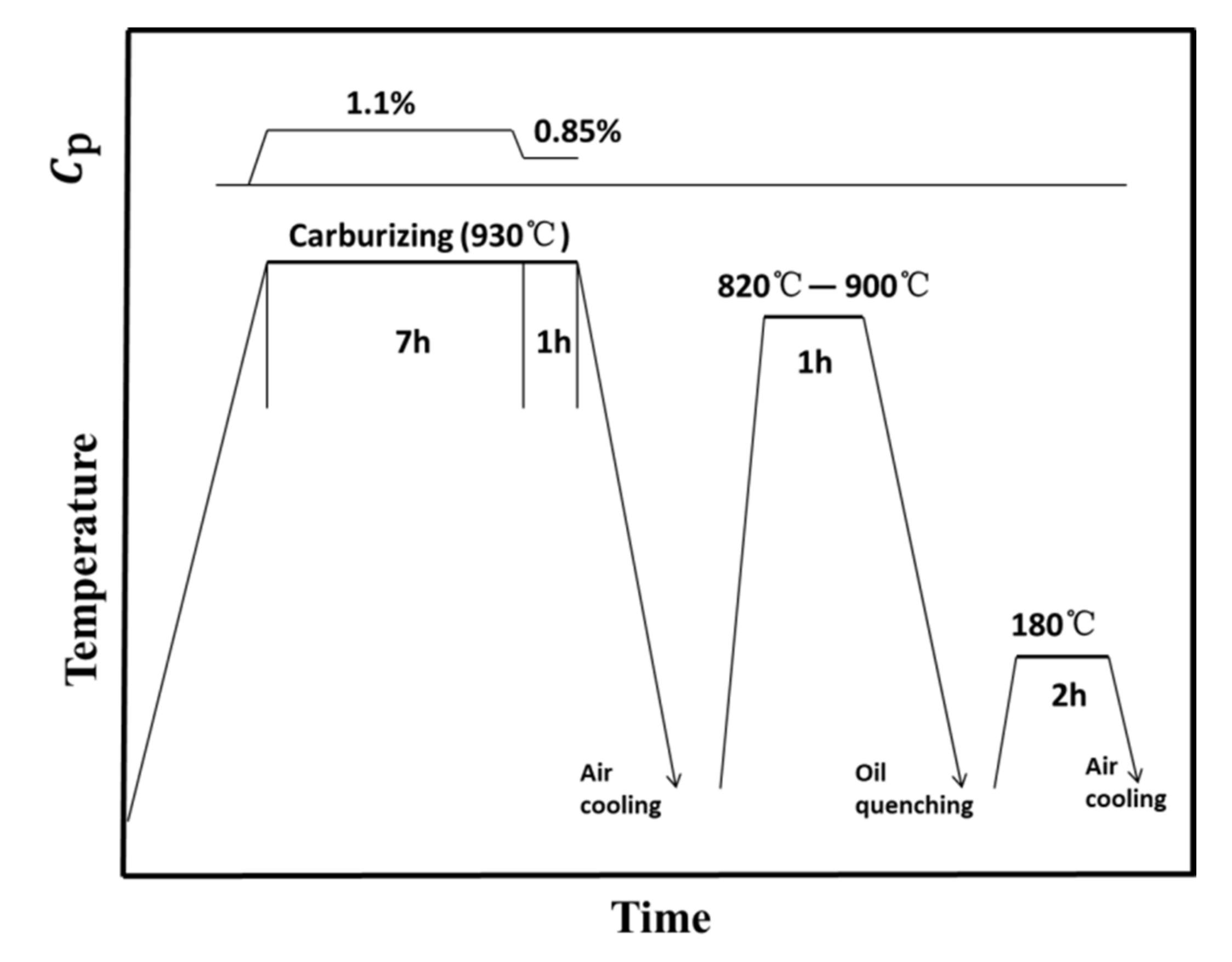

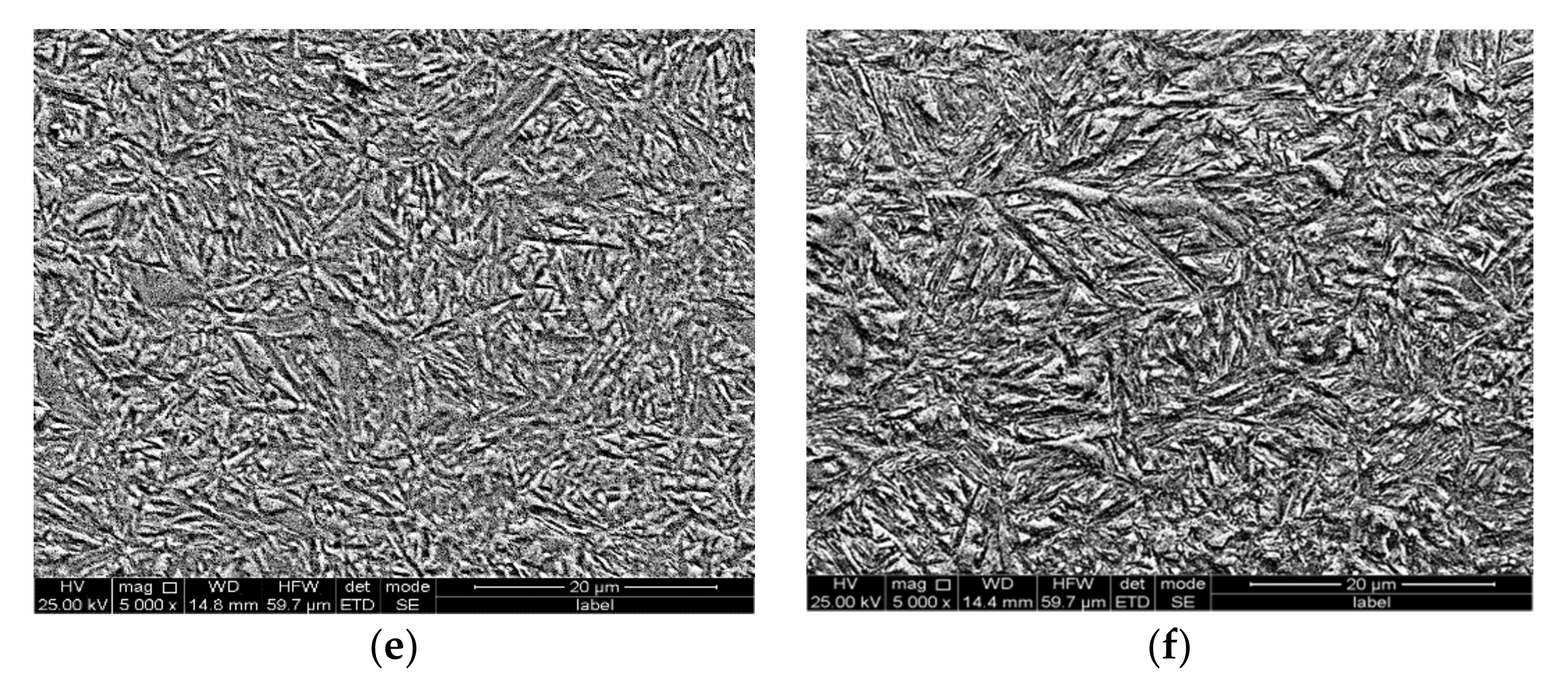
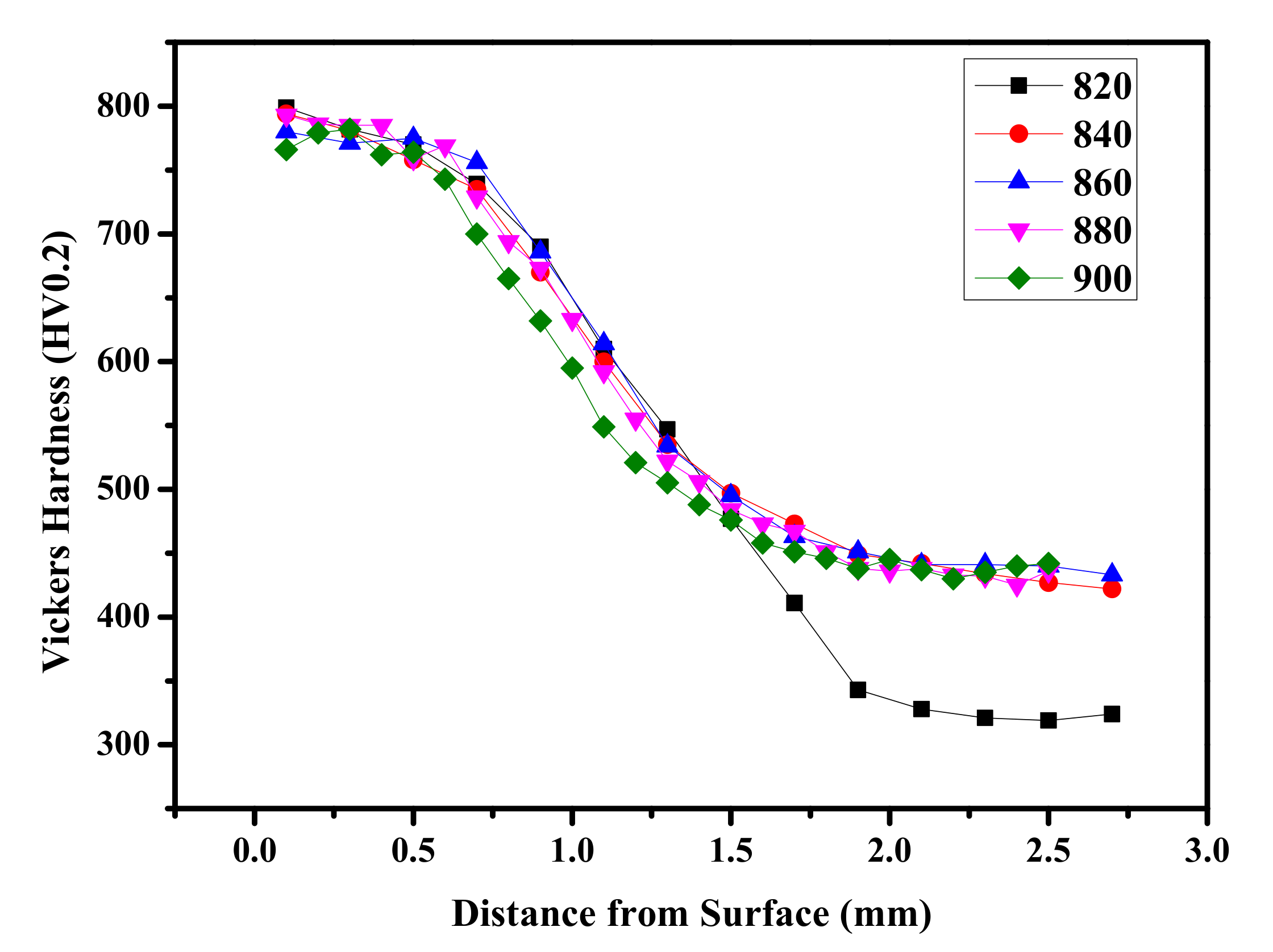
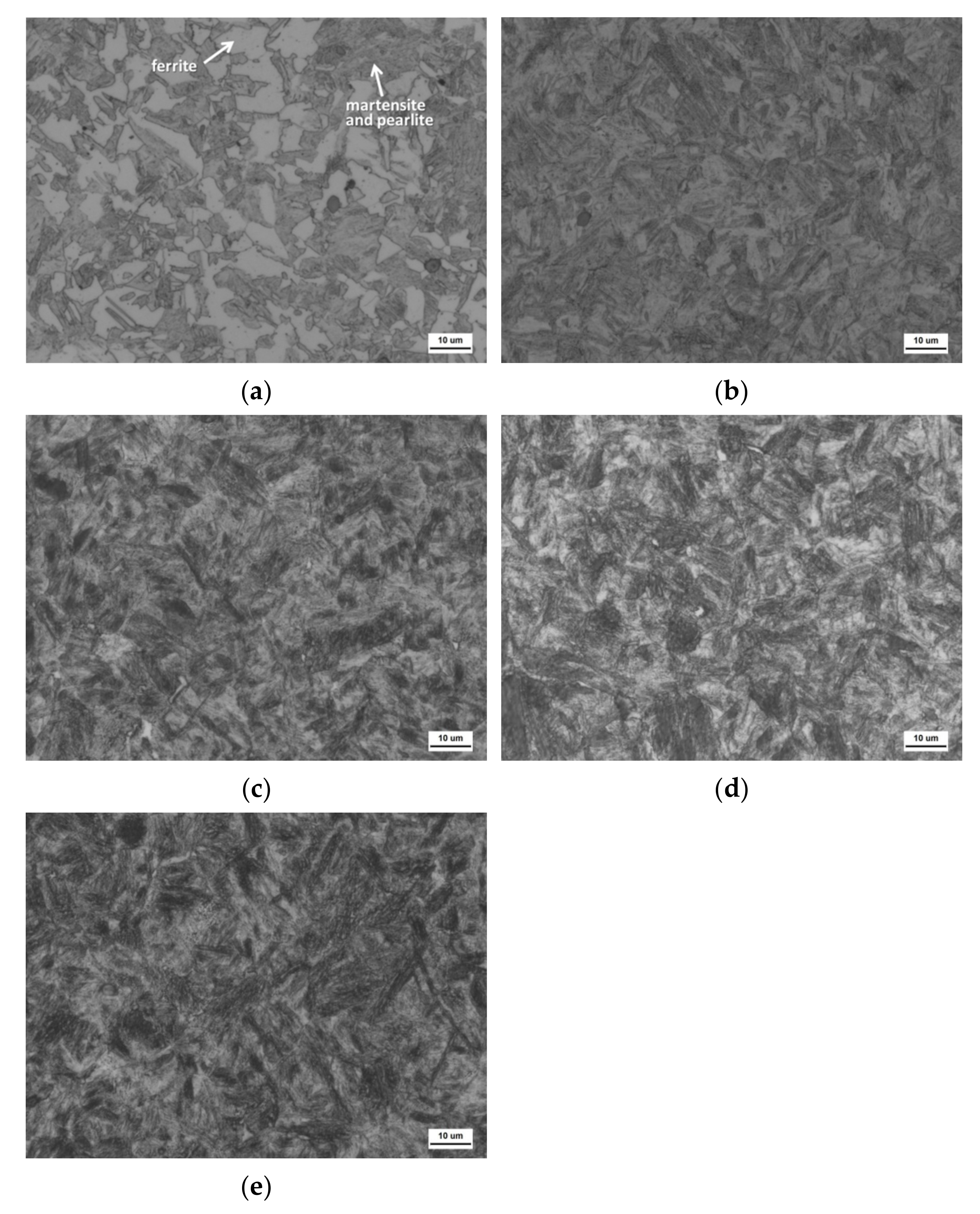
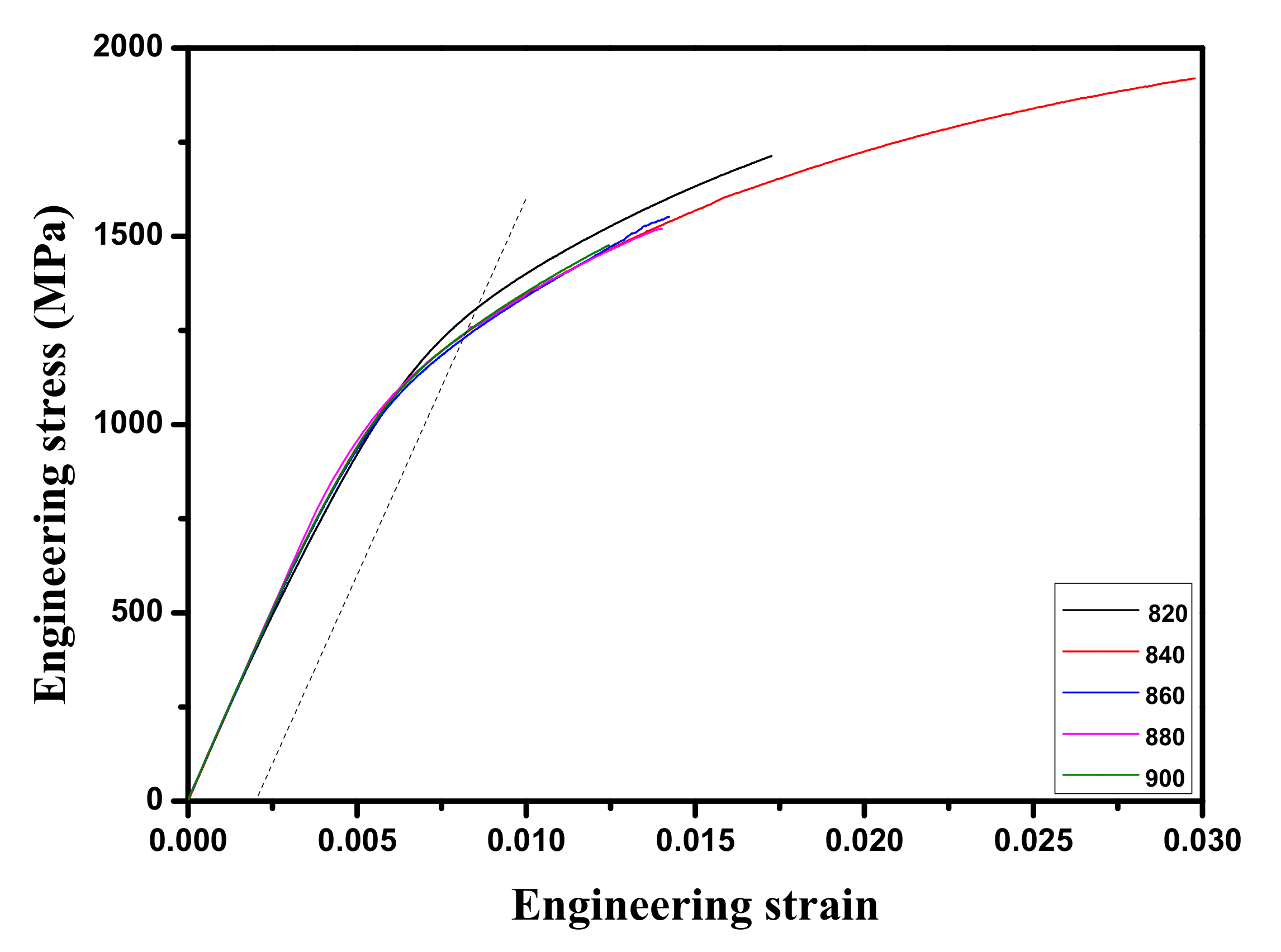




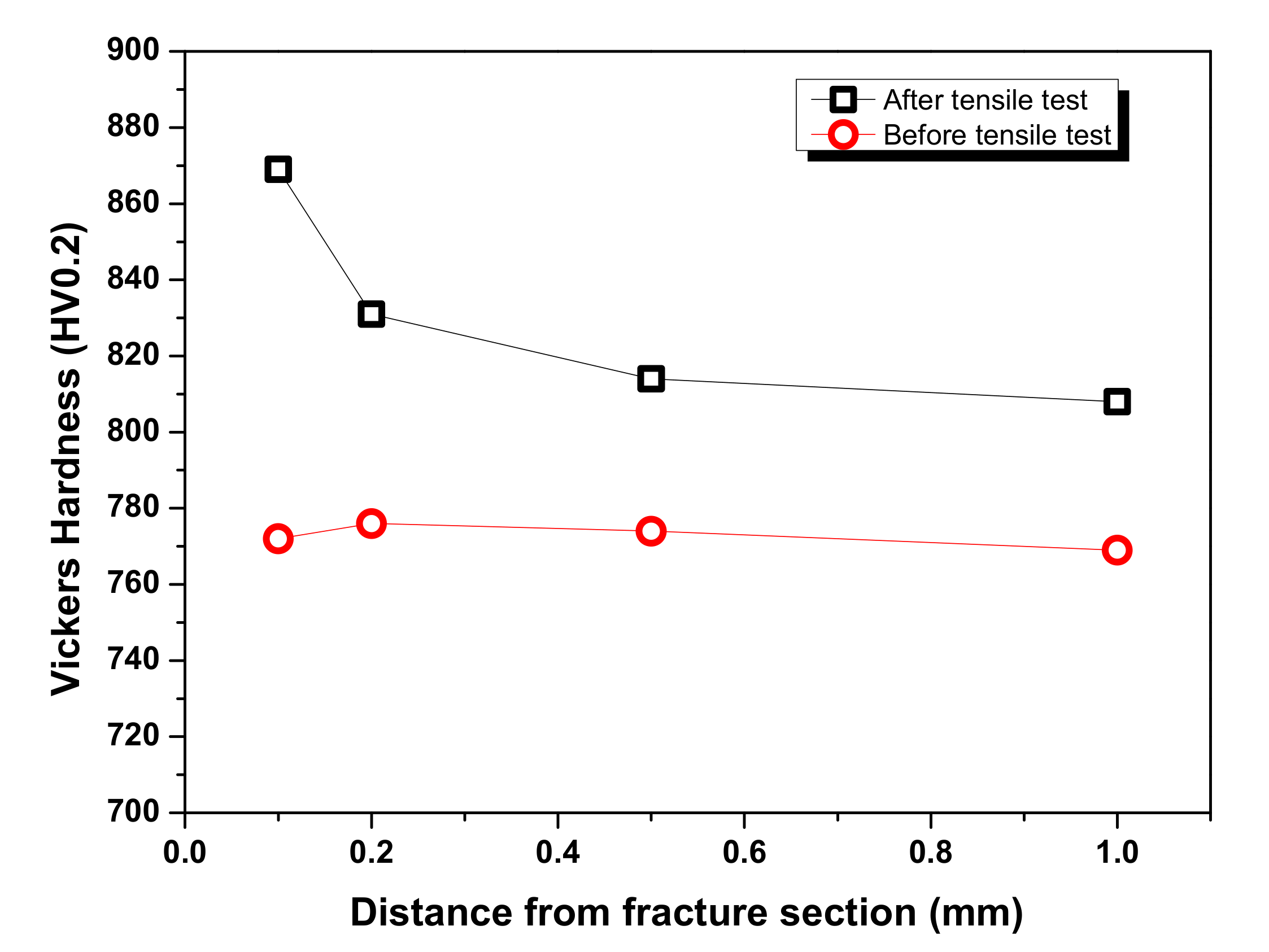
| C | Si | Mn | Cr | P | S | Fe |
|---|---|---|---|---|---|---|
| 0.16 | 0.08 | 1.22 | 1.22 | 0.014 | 0.024 | Bal. |
| Austenitizing Temperature, (°C) | Retained Austenite, Vγ (%) | Martensite Start Temperature, Ms (°C) | C Content in γ before Oil Quenching, (%) | Undissolved Carbides, (%) | α’, (%) |
|---|---|---|---|---|---|
| 820 | 18 | 177 | 0.73 | 2.0 | 80.0 |
| 840 | 25 | 143 | 0.81 | 0.7 | 74.3 |
| 860 | 30 | 130 | 0.84 | 0.2 | 69.8 |
| 880 | 23 | 151 | 0.79 | - | 77.0 |
| 900 | 21 | 164 | 0.76 | - | 79.0 |
| Austenitizing Temperature (°C) | Yield Stress (MPa) | Fracture Stress (MPa) | Tensile Elongation (%) |
|---|---|---|---|
| 820 | 1322 | 1713 | 1.7 |
| 840 | 1249 | 1919 | 3.0 |
| 860 | 1227 | 1552 | 1.4 |
| 880 | 1231 | 1519 | 1.4 |
| 900 | 1244 | 1476 | 1.2 |
| Austenitizing Temperature (°C) | Distance of Crack Initiation Site from Surface (mm) | Area of Intergranular Fracture (mm2) | Carbon Content at Crack Initiation Site (%) |
|---|---|---|---|
| 820 | 0.32 | 0.034 | 0.90 |
| 840 | 0.29 | 0.062 | 0.82 |
| 860 | 0.24 | 0.067 | 0.82 |
| 880 | 0.17 | 0.121 | 0.82 |
| 900 | 0.15 | 0.129 | 0.80 |
| Austenitizing Temperature (°C) | Initial Retained Austenite Fraction f0 (%) | Retained Austenite Fraction after Fracture fγ (%) |
|---|---|---|
| 820 | 18 | 10 |
| 840 | 25 | 9 |
| 860 | 30 | 19 |
| 880 | 23 | 14 |
| 900 | 21 | 14 |
Publisher’s Note: MDPI stays neutral with regard to jurisdictional claims in published maps and institutional affiliations. |
© 2021 by the authors. Licensee MDPI, Basel, Switzerland. This article is an open access article distributed under the terms and conditions of the Creative Commons Attribution (CC BY) license (http://creativecommons.org/licenses/by/4.0/).
Share and Cite
Chen, W.; He, X.; Yu, W.; Wang, M.; Yao, K. Microstructure, Hardness, and Tensile Properties of Vacuum Carburizing Gear Steel. Metals 2021, 11, 300. https://doi.org/10.3390/met11020300
Chen W, He X, Yu W, Wang M, Yao K. Microstructure, Hardness, and Tensile Properties of Vacuum Carburizing Gear Steel. Metals. 2021; 11(2):300. https://doi.org/10.3390/met11020300
Chicago/Turabian StyleChen, Wu, Xiaofei He, Wenchao Yu, Maoqiu Wang, and Kefu Yao. 2021. "Microstructure, Hardness, and Tensile Properties of Vacuum Carburizing Gear Steel" Metals 11, no. 2: 300. https://doi.org/10.3390/met11020300
APA StyleChen, W., He, X., Yu, W., Wang, M., & Yao, K. (2021). Microstructure, Hardness, and Tensile Properties of Vacuum Carburizing Gear Steel. Metals, 11(2), 300. https://doi.org/10.3390/met11020300





